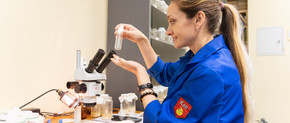Study Reveals Potential of Wood-Decaying Fungi in Complex Oncology Therapies
Two species of wood-decaying fungi can be used as protectors in the complex therapy of oncology (to reduce the effects of chemotherapy), and one species of mushroom can be used as a basis for an antitumor drug, biologists of the Ural Federal University and the Kazan Federal University have found. The scientists extracted extracts from four species of mushrooms (Inonotus obliquus (Chaga), Fomitopsis pinicola, Fomes fomentarius, and Ganoderma applanatum). They studied the effect of the biologically active substances of these mushrooms on flies (Drosophila melanogaster). It turned out that in certain quantities mushrooms do not cause stress in the body and do not damage DNA so they can be considered as a basis of drugs in the treatment of cancer. This was reported by biologists in an article in the International Journal of Medicinal Mushrooms. The study was financially supported by the Russian Ministry of Higher Education and Science (Project No. FEUZ-2024-0011).
“Scientists have described and demonstrated in vitro properties of the Aspergillus, such as antioxidant, antibacterial, antiviral, and anticancer activities. However, the effects of mushrooms on normal cells and the whole organism are poorly understood. In China and Korea, some mushrooms are widely used in traditional and official medicine as a source of medicinal substances. In our country, mushrooms have not yet been widely used in medicine, but we believe that they can be considered as potential agents for drugs”, says Alexander Yermoshin, Associate Professor of the Department of Experimental Biology and Biotechnology at UrFU.
Scientists decided to investigate whether fungi (potential drug candidates) harm the body. They tested the cytotoxicity of the extracts on Drosophila flies, and whether they caused stress and damaged DNA.
“There are many objects to screen – living cells, mice, rats, larger vertebrates. We chose Drosophila flies for preliminary screening. First, they reproduce rapidly and actively: a generation develops in 10 days, and a fly can lay up to 150 eggs per day. Second, their genome has been well studied and sequenced, and most importantly, there is a high degree of gene homology between Drosophila melanogaster and mammals. Therefore, for example, the results of the study of mushroom extracts on the detoxification of the body, which cancer drugs have during treatment, are extremely informative”, explains Olga Antosyuk, Associate Professor of the Department of Biodiversity and Bioecology at UrFU.
First, biologists studied the chemical composition and antioxidant activity of more than a dozen species of wood-decaying fungi found in the Middle Urals. Then they selected four species with the largest number and variety of secondary metabolites. Their activity was tested on flies.
It turned out that chaga protects cells from oxidative stress (has antioxidant activity), from free radicals (has the highest amount of phenolic compounds) and contains more amino acids compared to other samples. However, biologists consider the mushroom Fomes fomentarius as the most promising basis for complex therapy of oncology.
“We believe that Fomes fomentarius can be considered as a potential agent in a comprehensive antitumor therapy. This species of fungus has shown the least genetic activity in terms of DNA damage. This means that a drug based on this species may have the least impact on the body during therapy. Fomitopsis pinicola and Ganoderma applanatum showed DNA damage within acceptable levels. Therefore, they can be considered as potential candidates for protective agents. Of course, our research is still in its early stages, but the results we have obtained are very good. I think mushrooms have a future”, states Olga Antosyuk.
However, biologists caution us not to collect mushrooms in the forest to treat or prevent tumors. First of all, there are many species of mushrooms, and they all contain different compounds, largely depending on the tree on which they grow. Second, as studies by biologists have shown, high concentrations of extracts harm cells. For example, a high concentration of one type of fungus increased the lethality of mosquitoes: more than 50 percent of the larvae on this medium died.
The next stage of the work is to study the activity of the fungus Fomes fomentarius and its potential use as an anticancer drug and to continue to work on two candidate protectors. As Olga Antosyuk explains, such drugs are extremely important in complex cancer therapy because they help protect the body from the side effects of other drugs.

